
Sean Carroll, in a Cosmic Variance blog in August 2006 entitled Dark Matter Exists, including a comment there by Karel, said ( with my comment here set off by brackets [ ] ):
"... In the Bullet Cluster, more formally known as 1E 0657-56, we actually find two clusters of galaxies that have (relatively) recently passed right through each other. It turns out that the large majority (about 90%) of ordinary matter in a cluster is not in the galaxies themselves, but in hot X-ray emitting intergalactic gas. As the two clusters passed through each other, the hot gas in each smacked into the gas in the other, while the individual galaxies and the dark matter (presumed to be collisionless) passed right through. ...
[ I think that an animation sequence of what is happening would look like this

in which
... astrophysicists ... have now compared images of the gas obtained by the Chandra X-ray telescope to "maps" of the gravitational field deduced from weak lensing observations. Their paper is available ...[ at astro-ph/0608407 and astro-ph/0608408 ]... the answer is: there's definitely dark matter there! ...
Here is 1E 0657-56 in ... optical image, in which you can see the actual galaxies.
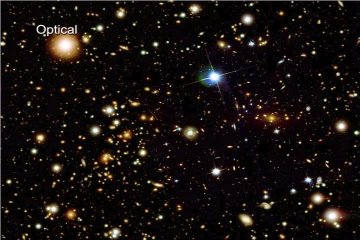
... you can map out the gravitational fields of the clusters, using weak gravitational lensing. That is, you take very precise pictures of galaxies that are in the background of these clusters. The images of the background galaxies are gently distorted by the gravitational field of the clusters. The distortion is so gentle that you could never tell it was there if you only looked at one galaxy; but with more than a hundred galaxies, you begin to notice that the images are systematically aligned, characteristic of passing through a coherent gravitational lens. From these distortions it's possible to work backwards and ask "what kind of mass concentration could have created such a gravitational lens?" Here's the answer, superimposed on the optical image.
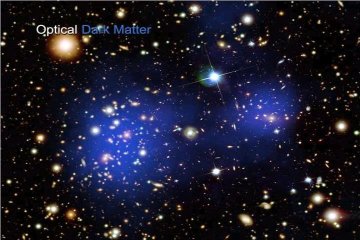
It's about what you would expect: the dark matter is concentrated in the same regions as the galaxies themselves. But we can separately make X-ray observations to map out the hot gas, which constitutes most of the ordinary (baryonic) matter in the cluster. Here's what we see.
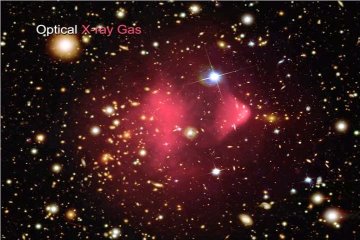
This is why it's the "Bullet" cluster &emdash; the bullet-shaped region on the right is a shock front. These two clusters have passed right through each other, creating an incredibly energetic collision between the gas in each of them. The fact that the "bullet" is so sharply defined indicates that the clusters are moving essentially perpendicular to our line of sight.
This collision has done exactly what we want &emdash; it's swept out the ordinary matter from the clusters, displacing it with respect to the dark matter (and the galaxies, which act as collisionless particles for these purposes). You can see it directly by superimposing the weak-lensing map and the Chandra X-ray image.
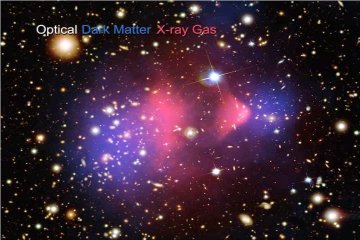
... now we have established beyond reasonable doubt that we need a substantial amount of dark matter to explain cosmological dynamics. ...
...
...
What about dark energy?
The characteristic features of dark energy are that it is smooth (spread evenly throughout space) and persistent (evolving slowly, if at all, with time). ... these observations don't tell us anything directly about the nature of the 70% of the universe that is purportedly in this ultra-exotic component. ...".
In my D4-D5-E6-E7-E8 VoDou Physics model:
In the D4-D5-E6-E7-E8 VoDou Physics model, our 4-dimensional Physical SpaceTime Universe begins as a relatively small spatial volume that is entirely high-energy unispace, in which all 15 generators of Conformal Spin(2,4) Unispace, including the 4 Conformal GraviPhoton generators, are effective.

After some expansion, some regions of our Universe become Gravitationally Bound Domains (such as, for example, Galaxies) in which the 4 Conformal GraviPhoton generators are frozen out, forming domains within our Universe like IceBergs in an Ocean of Water. Note that Gravitationally Bound Domains are defined by their gravitational accelerations, not by their size - there is no correlation with system size.The process of formation of Gravitationally Bound Domains releases (like latent heat of fusion when Ice freezes from Water) the excess of the Conformal Unienergy of Unispace over the Poincare Energy of Minkowski space.
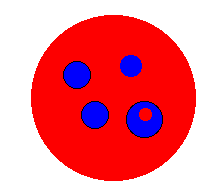
Note that, within the Gravitationally Bound Domains there can exist Islands of Unispace in which all 15 generators of Conformal Spin(2,4) remain effective (such as, for example, Protostar Clouds of Dust and Gas - like Puddles of Water on an IceBerg floating in an Ocean of Water - When a Protostar Clouds of Dust and Gas condense to form the Gravitationally Bound Domain of a Star and its Planets, the process releases (like latent heat of fusion when Ice freezes from Water) the excess of the Conformal Unienergy of Unispace over the Poincare Energy of Minkowski space). During and after more expansion of our Universe as a whole, the Gravitationally Bound Domains do not expand within themselves, but are carried apart from each other as in the familiar example of inflating a Balloon with Coins glued to its surface.
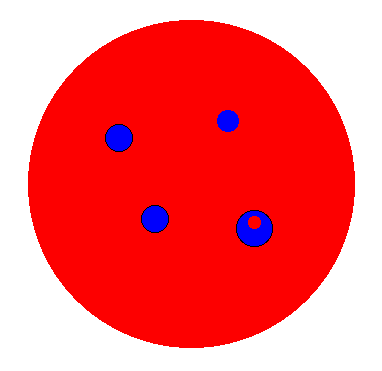
Since our laboratories on our Earth are Gravitationally Bound Domains, our conventional experiments on Earth only see the Poincare Energy of Minkowski space. However, since the Pioneer spacecraft are not bound to our Solar System, the Pioneer Spacecraft are experiments beyond the Gravitationally Bound Domain of our Earth-Sun Solar System.
In tightly bound systems like our Solar System within the orbit of Uranus, the Special Conformal Degrees of Freedom are completely frozen out and are not observed by experiments.
However, in Swiss-Cheese systems such as Galaxies which have substantial regions in which the Special Conformal Degrees of Freedom are not frozen, but the total system of the Galaxy is bound and does rotate, the Special Conformal Degrees of Freedom do not expand the Galaxy, but act to modify the rotation of the Galaxy in a way equivalent to MOND.
In more detail, in my D4-D5-E6-E7-E8 VoDou Physics model, Gravity and the Cosmological Constant come from the MacDowell-Mansouri Mechanism and the 15-dimensional Spin(2,4) = SU(2,2) Conformal Group, which is made up of:
According to gr-qc/9809061 by R. Aldrovandi and J. G. Peireira:
"... By the process of Inonu-Wigner group contraction with R -> oo ...[where R ]... the de Sitter pseudo-radius ... , both de Sitter groups ... with metric ... (-1,+1,+1,+1,-1) ...[or]... (-1,+1,+1,+1,+1) ... are reduced to the Poincare group P, and both de Sitter spacetimes are reduced to the Minkowski space M. As the de Sitter scalar curvature goes to zero in this limit, we can say that M is a spacetime gravitationally related to a vanishing cosmological constant.On the other hand, in a similar fashion but taking the limit R -> 0, both de Sitter groups are contracted to the group Q, formed by a semi-direct product between Lorentz and special conformal transformation groups, and both de Sitter spaces are reduced to the cone-space N, which is a space with vanishing Riemann and Ricci curvature tensors. As the scalar curvature of the de Sitter space goes to infinity in this limit, we can say that N is a spacetime gravitationally related to an infinite cosmological constant.
If the fundamental spacetime symmetry of the laws of Physics is that given by the de Sitter instead of the Poincare group, the P-symmetry of the weak cosmological-constant limit and the Q-symmetry of the strong cosmological-constant limit can be considered as limiting cases of the fundamental symmetry. ...
... N, whose geometry is gravitationally related to an infinite cosmological constant, is a 4-dimensional cone-space in which ds = 0, and whose group of motion is Q. Analogously to the Minkowski case, N is also a homogeneous space, but now under the kinematical group Q, that is, N = Q/L. In other words, the point-set of N is the point-set of the special conformal transformations. Furthermore, the manifold of Q is a principal bundle P(Q/L,L), with Q/L = N as base space and L as the typical fiber. The kinematical group Q, like the Poincare group, has the Lorentz group L as the subgroup accounting for both the isotropy and the equivalence of inertial frames in this space. However, the special conformal transformations introduce a new kind of homogeneity. Instead of ordinary translations, all the points of N are equivalent through special conformal transformations. ...
... Minkowski and the cone-space can be considered as dual to each other, in the sense that their geometries are determined respectively by a vanishing and an infinite cosmological constants. The same can be said of their kinematical group of motions: P is associated to a vanishing cosmological constant and Q to an infinite cosmological constant.
The dual transformation connecting these two geometries is the spacetime inversion x^u -> x^u / sigma^2 . Under such a transformation, the Poincare group P is transformed into the group Q, and the Minkowski space M becomes the cone-space N. The points at infinity of M are concentrated in the vertex of the cone-space N, and those on the light-cone of M becomes the infinity of N. It is interesting to notice that, despite presenting an infinite scalar curvature, the concepts of space isotropy and equivalence between inertial frames in the cone-space N are those of special relativity. The difference lies in the concept of uniformity as it is the special conformal transformations, and not ordinary translations, which act transitively on N. ...
... in the light of the recent supernovae results ... favoring possibly quite large values for the cosmological constant, the above results may acquire a further relevance to Cosmology ...".
Since the Cosmological Constant comes from the 10 Rotation, Boost, and Special Conformal generators of the Conformal Group Spin(2,4) = SU(2,2), the fractional part of our Universe of the Cosmological Constant should be about 10 / 15 = 67%.
Since Black Holes, including Dark Matter Primordial Black Holes, are curvature singularities in our 4-dimensional physical spacetime, and since Einstein-Hilbert curvature comes from the 4 Translations of the 15-dimensional Conformal Group Spin(2,4) = SU(2,2) through the MacDowell-Mansouri Mechanism (in which the generators corresponding to the 3 Rotations and 3 Boosts do not propagate), the fractional part of our Universe of Dark Matter Primordial Black Holes should be about 4 / 15 = 27%.
Since Ordinary Matter gets mass from the Higgs mechanism which is related to the 1 Scale Dilatation of the 15-dimensional Conformal Group Spin(2,4) = SU(2,2), the fractional part of our universe of Ordinary Matter should be about 1 / 15 = 6%.
Therefore, our Flat Expanding Universe should, according to the cosmology of the D4-D5-E6-E7-E8 VoDou Physics model, have, roughly:
As Dennnis Marks pointed out to me, since:
the ratio of their overall average densities must vary with time, or scale factor R of our Universe, as it expands so that the above calculated ratio 0.67 : 0.27 : 0.06 is valid only for a particular time, or scale factor, of our Universe, and
that is a time near our present time at which WMAP measures that ratio to be 0.73 : 0.23 : 0.04 (in my opinion very close to the above caculated ratio).
His remarks are substantially equivalent to a question that Michael S. Turner, in astro-ph/0202005, calls "... The Nancy Kerrigan Problem ... in the past dark energy was unimportant and in the future it will be dominant! We just happen to live at the time when dark matter and dark energy have comparable densities. In the words of Olympic skater Nancy Kerrigan, "Why me? Why now?". In other words:
Since WMAP observes Ordinary Matter at 4% NOW,
the time WHEN Ordinary Matter was 6% would be at redshift z such that 1 / (1+z)^3 = 0.04 / 0.06 = 2/3 , or (1+z)^3 = 1.5 , or 1+z = 1.145 , or z = 0.145. To translate redshift into time, in billions of years before present, or Gy BP, use this chart
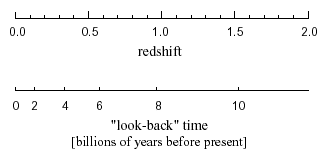
from a www.supernova.lbl.gov file SNAPoverview.pdf. to see that
the time WHEN Ordinary Matter was 6% would have been a bit over 2 billion years ago, or 2 Gy BP.
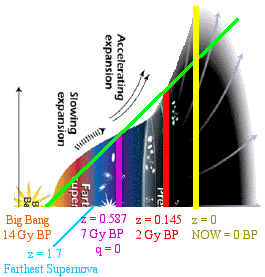
In the diagram, there are four Special Times in the history of our Universe:
Those four Special Times define four Special Epochs:
NOW happens to be about 2 billion years into the Late Accelerating Expansion Epoch.
The Copernican insight that Earth, the home of Humanity and its precursor Life, is Not Special in our Solar System (and also its place among the stars of our Milky Way Galaxy) led us to understand the true structure of our Solar System and our Milky Way Galaxy.
Our present insight that the Time of Life on Earth, from the Proterozoic begining of Eukaryotic Life to Present-Day Humanity, covers the 2 billion years beginning with a Special Time in the Time-History of our Universe leads us to a better understanding of the Unification of Gravity / Particle Physics / Mathematics / Information / Consciousness, and perhaps to a better understanding our our ultimate Fate.
Therefore:
What about Dark Energy /\ and Cold Dark Matter during the past 2 Gy ?
Since Cold Dark Matter = Primordial Black Holes (PBH):
The above calculation of 2 Gy BP for the ratio 0.67 : 0.27 : 0.06 is based only on the decline in the Ordinary Matter component with expansion of Space, so it is only a rough estimate, in that it ignores such things as decay of Ordinary Matter protons by GUT (10^31 year lifetime) or by Black Hole processes (10^64 year lifetime), which would be less important during the relevant time periods near NOW than in the Black Hole and Dark Eras of the distant future.
Jack Sarfatti said (in the context of his physics/cosmology model): "... "... I am also saying that lepto-quarks [leptons and quarks] have dark matter cores on small scale. It's /\zpf < 0 that keeps electron stable. Think, naively for the nonce, of electron as a shell of electric charge with an inner /\zpf < 0 core. It looks like a "point" from huge effective curvature of /\zpf. ...".That idea is not only interestingly similar to the idea of /\zpf < 0 haloes helping to hold galaxies together, but also seems very much like the Compton Radius Vortex model of leptons and quarks as Kerr-Newman black holes with no cosmic censorship of their naked singularities.
Also, perhaps the concept of Primordial Black Holes as Cold Dark Matter might be a particle manifestation of the part of /\zpf < 0 that is not found in the center of /\ = 0 Ordinary Matter leptons and quarks. If that viewpoint is correct, in view of the WMAP ratio of 73% - 23% - 4% of /\ > 0 , /\ < 0, /\ = 0, there should be a lot more mass in /\ < 0 Primordial Black Holes than in /\ = 0 leptons and quarks.
Further, Cold Dark Matter cores of leptons and quarks seems consistent with an association of Ordinary Matter with production of Cold Dark Matter in early times of our Universe.
As to how the Dark Energy /\ and Cold Dark Matter terms have evolved during the past 2 Gy, a rough estimate analysis would be, for Cold Dark matter = PBH:
The Ordinary Matter excess 0.06 - 0.04 = 0.02 plus the first-order CDM excess 0.27 - 0.18 = 0.09 should be summed to get a total first-order excess of 0.11, which in turn should be distributed to the /\ and CDM factors in their natural ratio 67 : 27, producing, for NOW after 2 Gy of expansion:
so that the present ratio of 0.73 : 0.23 : 0.04 observed by WMAP seems to me to be consistent with the cosmology of the D4-D5-E6-E7-E8 VoDou Physics model with Cold Dark Matter = PBH.
In my D4-D5-E6-E7-E8 VoDou Physics model, Swiss-Cheese systems such as Galaxies which have substantial regions in which the Special Conformal Degrees of Freedom are not frozen, but the total system of the Galaxy is bound and does rotate, the Special Conformal Degrees of Freedom do not expand the Galaxy, but act to modify the rotation of the Galaxy in a way equivalent to MOND.
In astro-ph/0112069, Mordehai Milgrom says:
"... In the early 1980s I proposed a modifed-dynamics ... based on the fact that typical accelerations in galactic systems are many orders of magnitude smaller than those encountered in the solar system. ... This modified dynamics, MOND, introduces a constant with the dimensions of an acceleration, a_0, and posits that standard Newtonian dynamics is a good approximation only for accelerations that are much larger than a_0. ... the basic point of MOND, from which follow most of the main predictions, can be simply put as follows: a test particle at a distance r from a large mass M is subject to the acceleration a given by
a^2 / a_0 = M G r^(-2)
when a << a_0, instead of the standard expression a = M G r^(-2) , which holds when a >> a_0. ... The value of the acceleration constant a_0 that fits all the data discussed ...[ in the paper ]... is about 10^(-8) cm s^(-2) ...
... One immediate result ... is that at a large radius around a mass M, the orbital speed on a circular orbit becomes independent of radius. This indeed was a guiding principle in the construction of MOND, which took asymptotic flatness of galaxy rotation curves as an axiom ... When we count the mass of baryonic matter in such systems - in stars, neutral and high-T gas, etc.- the total sum does not provide enough gravity to explain the observed accelerations in such systems within standard physics. If we adhere to standard dynamics, the need for dark matter is the only solution we can conceive. It is, however, possible that the laws of dynamics, proven in the laboratory and the solar system, cannot be simply applied in the realm of the galaxies. ... Regarding galactic systems other than galaxies, the comparison of the systematics of the observed mass discrepancy with the expectations from MOND are shown in Figure 2
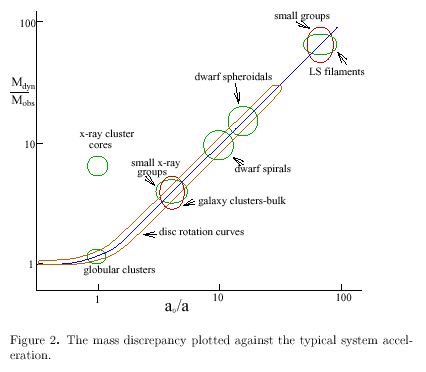
in Milgrom (1998) [ astro-ph/9810302 , which says:
"... MOND is not a modification at large distances, but at low accelerations - which for a given mass are attained at large distances ... there is no correlation of the discrepancy with system size. ...
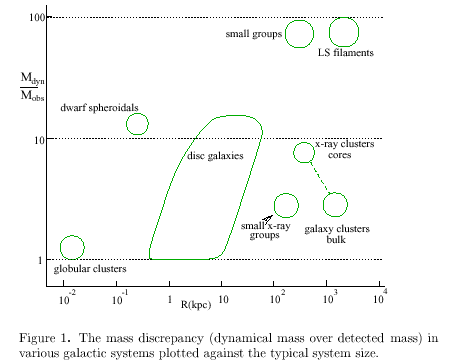
... in particular ... the small dwarf spheroidals and LSB discs show large discrepancies, while the large galaxy clusters evince only moderate discrepancies...." ].
... based on analyzes referenced there.
The agreement is uniform, with one exception: The cores of rich x-ray clusters of galaxies show a considerable mass discrepancy, while, according to MOND there shouldn't be any, because the accelerations there are only of the order of a_0, and not much smaller. ( Application of MOND to the clusters at large, say within a few megaparsecs of the center, does predict correctly the mass discrepancy. ) The resolution, by MOND, will have to be that these cores harbor large quantities of still undetected baryonic matter, perhaps in the form of dim stars, perhaps as warm gas. The environment, and history, of these cores is so unlike others that this would not be surprising. ...
.. in interpreting data we equate observed accelerations with the gravitational field ... We can exemplify this point by considering the claimed anomaly in the motions of the Pioneer 10 and 11 spacecraft. Analysis of their motion have shown an unexplained effect ...[ see Anderson & al 2001, Study of the anomalous acceleration of Pioneer 10 and 11, gr-qc/0104064 ]... that can be interpreted as being due to an unexplained constant acceleration towards the sun of about 7 x 10^(-8) cm s^(-2) , of the order of a_0. ... MOND could naturally explain such an anomalous acceleration ... It may well be that the modification enters the Pioneers motion, which corresponds to unbound, hyperbolic motions, and the motion of bound, and quasi-circular trajectories in a different way. ...
... It is worth pointing out that in such a modified-gravity theory, the deep-MOND limit ... the deep-MOND regime ( a << a_0 ) ... corresponds to a theory that is conformally invariant, as discussed in Milgrom (1997) [ gr-qc/9705003 which says:
"... The Poisson equation describes many physical problems in linear media such as electrostatics, magnetostatics, steady-state diffusion and other potential flows in the presence of sources and sinks, and, of course, Newtonian gravity. It can be generalized ... to describe, for example, non-linear media with a response coefficient (dielectric constant, permeability, diffusion coefficient, etc.) that is a function of the field strength. ... For example, ... as a modification of Newtonian gravity to replace the dark-matter hypothesis for galactic systems ... In the modified dynamics discussed as an alternative to dark matter, phenomenology requires just this ... conformally invariant (CI) ... Our results here apply then in the large-distance limit of this theory. ...". ]. ...
... this asymptotic rotational speed depends only on the total mass M via V^4 = M G a_0 . This, according to MOND, is the fact underlying the observed Tully-Fisher-type relations, by which the typical (mean) rotational velocity, V , in a disc galaxy is strongly correlated with the total luminosity of the galaxy, L, in a relation of the form L ...[ proportional to ]... V^alpha . The power alpha is around 3-4, and depends on the wavelength band at which L is measured. The close agreement between this TF [ Tully-Fisher-type ] relation and the prediction of MOND is encouraging; but, to test MOND more precisely on this count, one would have to bridge properly the mass-asymptotic-velocity MOND relation with the commonly presented luminosity-bulk-velocity TF relation. One should use the luminosity in a band where it is a good representative of the stellar mass, take into account not only the stellar mass, as represented by the luminosity, but also the contribution of gas to the mass, and use the asymptotic velocity, as opposed to other measures of the rotational velocity. It has emerged recently ... that if one does all this one indeed obtains a tight and accurate relation of the form predicted by MOND. ...".
In gr-qc/0007006, Paola Zizzi says:
"... the vacuum-dominated early inflationary universe ... is a superposed quantum state of qubits. ...... the early universe had a conscious experience at the end of inflation, when the superposed quantum state of ... [ 10^18 = N quantum qubits ] ... underwent Objective Reduction. The striking point is that this value of [ N ] equals the number of superposed tubulins-qubits in our brain ...
... [ in the inflationary phase of our universe ] ... the quantum register grows with time. In fact,
at each time step
... [ Tn = (n+1) Tplanck (where Tplanck = 5.3 x 10^(-44) sec) ] ...
a Planckian black hole, ... the n=1 qubit state 1 which acts as a creation operator, supplies the quantum register with extra qubits. ...
At time Tn = (n+1) Tplanck the quantum gravity register will consist of (n+1)^2 qubits. [ Let N = (n+1)^2 ] ...
By the quantum holographic principle, we associate N qubits to the nth de Sitter horizon ... remember that |1> = Had|0> where Had is the Hadamard gate ... the state ... [ of N qubits ] ... can be expressed as
... [ |N> = ( Had|0> )^N ] ...
As the time evolution is discrete, the quantum gravity register resembles more a quantum cellular automata than a quantum computer. Moreover, the quantum gravity register has the peculiarity to grow at each time step ( it is self-producing ). If we adopt an atemporal picture, then the early inflationary universe can be interpreted as an ensemble of quantum gravity registers in parallel ... which reminds us of the many-worlds interpretation. ...
The superposed state of quantum gravity registers represents the early inflationary universe which is a closed system. Obviously then, the superposed quantum state cannot undergo environmental decoherence. However, we know that at the end of the inflationary epoch, the universe reheated by getting energy from the vacuum, and started to be radiation-dominated becoming a Friedmann universe. This phase transition should correspond to decoherence of the superposed quantum state. The only possible reduction model in this case is self-reduction ...
during inflation, gravitational entropy and quantum entropy are mostly equivalent ...
Moreover ... The value of the cosmological constant now is
... /\N = 10^(-56) cm^(-2) ...
in agreement with inflationary theories.
If decoherence of N qubits occurred now, at Tnow = 10^60 Tplanck
( that is, n = 10^60, N = 10^120 )
here would be a maximum gravitational entropy
... [ maximum entropy Smax = N ln2 = 10^120 ] ...
In fact, the actual entropy is about
... [ entropy now Snow = 10^101 ] ...
[Therefore] decoherence should have occurred for
... [ Ndecoh = 10^(120-101) = 10^19 = 2^64 ] ...
which corresponds to ... [ n = 9 and to ] ... the decoherence time
... [ Tdecoh = 10^9 Tplanck = 10(-34) sec ] ...".
Ndecoh = 10^19 = 2^64
The self-reflexivity property of the 2^64-dimensional Clifford algebra Cl(64) causes self-decoherence !
From the point of view of my D4-D5-E6-E7-E8 Vodou Physics model, the fundamental structure is the 2^8 = 256-dimensional Cl(8) Clifford algebra, which can be described by 2^8 qubits.
Our inflationary universe decoheres when it has Ndecoh = 2^64 qubits.
What is special about 2^64 qubits ?
2^64 qubits corresponds to the Clifford algebra Cl(64) = Cl(8x8).
By the periodicity-8 theorem of real Clifford algebras that
Cl(K8) = Cl(8) x ... tensor product K times ... x Cl(8),
we have:
Cl(64) = Cl(8x8) =
= Cl(8) x Cl(8) x Cl(8) x Cl(8) x Cl(8) x Cl(8) x Cl(8) x Cl(8)
Therefore,
Cl(64) is the first ( lowest dimension ) Clifford algebra at which we can reflexively identify each component Cl(8) with a vector in the Cl(8) vector space.
This reflexive identification/reduction causes decoherence.
It is the reason that our universe decoheres at N = 2^64 = 10^19,
so that inflation ends at age 10^(-34) sec.
Note that Ndecoh = 2^64 = 10^19 qubits is just an order of magnitude larger than the number of tubulins Ntub = 10^18 of the human brain. In my model of Quantum Consciousness ( and that of Jack Sarfatti ), conscious thought is due to superposition states of those 10^18 tubulins. Since a brain with Ndecoh = 10^19 tubulins would undergo self-decoherence and would therefore not be able to maintain the superposition necessary for thought, it seems that the human brain is about as big as an individual brain can be. The Zizzi Self-Decoherence can be compared to GRW decoherence.
At the end of inflation:
Each qubit at the end of inflation corresponds to a Planck Mass Black Hole, which in the D4-D5-E6-E7-E8 physics model undergoes decoherence and, in a process corresponding to Reheating in the Standard Inflationary Model, after the end of inflation and during reheating, the fate of each Planck Mass Black Hole is governed by Conformal Gravity, producing either
The 4 to 1 ratio of Special Conformal Transformations to Dilation determines that the fundamental ratio of Dark Matter to Ordinary Matter will be about 4 to 1.
Here is a very rough estimate of the number of Ordinary Matter particles in our universe, produced by reheating from a population of (2^64)^2 = 2^128 = 10^38 fermion pairs populating the Universe Immediately After Inflation:
Since, as Paola Zizzi says in gr-qc/0007006, ( with some editing by me denoted by [ ] ):"... the quantum register grows with time. ... At time Tn = (n+1) Tplanck the quantum gravity register will consist of (n+1)^2 qubits. [ Let N = (n+1)^2 ] ...",we have the number of qubits at the next time step (Reheating)
Nreh = ( n_reh )^2 = ( 2^128 )^2 = 2^256 = 10^77
Since each qubit at Reheating should correspond, for the Ordinary Matter component, to fermion particle-antiparticle pairs that average about 0.66 GeV, we have the results that
the number of particles in our Universe at Reheating is about 10^77 nucleons.
After Reheating, our Universe enters the Radiation-Dominated Era, and, since there is no continuous creation, particle production stops, so
the 10^77 nucleon Baryonic Mass of our Universe has been mostly constant since Reheating, and will continue to be mostly constant until Proton Decay.
The present scale of our Universe is about R(tnow) = 10^28 cm, so that its volume is now about 10^84 cm^3, and its baryon density is now about 10^77 protons / 10^84 cm^3 = 10^(-7) protons/cm^3 = 10^(-7-19-5) gm / cm^3 = 10^(-31) gm / cm^3 = roughly the baryonic mass density of our Universe.
Since the critical density of our Universe is about 10^(-29) gm / cm^3, it is likely that the excess of the critical mass of our Universe over its baryonic mass is due to Dark Matter Primordial Stable Planck Mass Black Holes and Dark Energy.